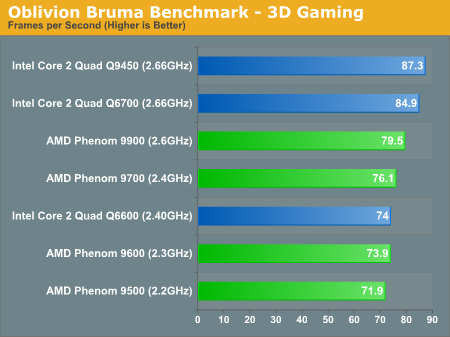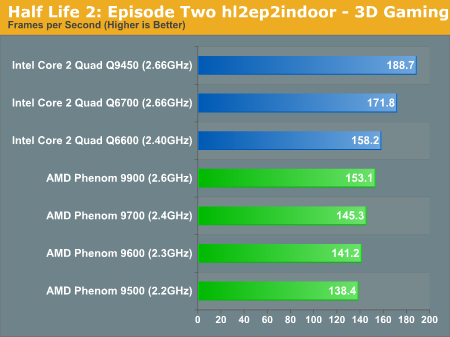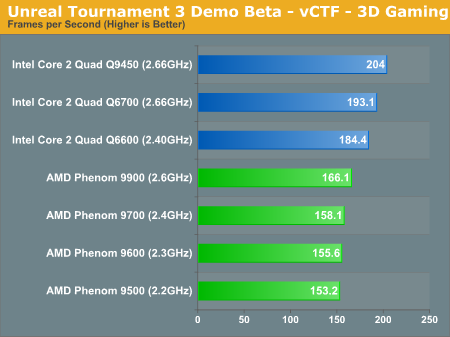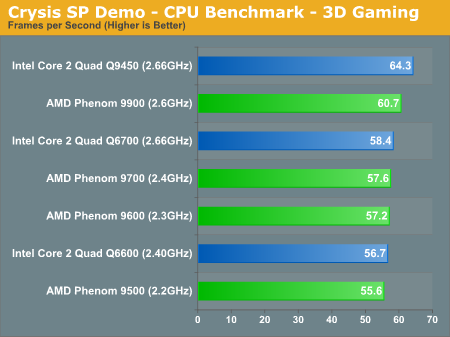AMD's Phenom Unveiled: A Somber Farewell to K8
by Anand Lal Shimpi on November 19, 2007 1:25 AM EST- Posted in
- CPUs
Gaming Performance
To highlight CPU performance differences, all of our 3D gaming benchmarks were run at 1024 x 768, so keep in mind that real world gameplay will most likely be at more GPU bound resolutions with CPU differences mattering less. That being said, this is a CPU review, so we do want to know which of these chips runs game-code the best.
It turns out that gaming performance is really a mixed bag; there are a couple of benchmarks where AMD really falls behind (e.g. Half Life 2 and Unreal Tournament 3), while in other tests AMD is actually quite competitive (Oblivion & Crysis).




While Phenom suffers greatly in video encoding and 3D rendering tests, there is hope for it as the 9700 can actually compete clock-for-clock with Core 2 in some games. If all you do is game on your machine, with the right video cards you'd be hard pressed to notice the difference between a Phenom and a Core 2 system - that being said, if you're looking at quad-core, chances are that you're doing something else with your system other than game.










124 Comments
View All Comments
strikeback03 - Monday, November 19, 2007 - link
Good idea, but didn't they pick the wrong parts to focus on? I doubt many of these quad-cores are going to find their way into budget systems, which is where they might see significant sales volume. Unless AMD is hoping hype from the Phenom launch will turn into better sales of Athlon X2 systems, it is odd to focus on parts which are high-end for your current line but not in the greater market.
MrKaz - Monday, November 19, 2007 - link
Well I have seen reports that AMD is expecting o release higher clock speed up to 3.0Ghz.Now when Intel releases the X6800 at 2.93Ghz it was already obvious the CPU at max would do 3.06Ghz with model 6900.
Now AMD with the 9900 at 2.6Ghz, 9800 at 2.5GHz, 9700 at 2.4GHz, ...
Tell me what model name will AMD use with the 2.7GHz part?
At least Intel with the 6800 still had the 7xxx, 8xxx, 9xxx.
Since this is a new product isn’t it strange, unless AMD will kill it soon with Phenom 2, but then again why not release it as Athlon X4?
I understand the needs of AMD to match the future Intel model numbers, but however it fails miserably since its higher model number fails to meet the performance expectations.
gunnyjoe - Monday, November 19, 2007 - link
What gives? This was a LOUSY review, something I don't expect from Anadtech. If you want a THOROUGH review, try Tom's Hardware. Anand, please remove your lips from Intel's stinking rear end long enough to actually review the competition's products.For those of you switching to Intel, I hope you enjoy replacing your entire platform AGAIN next year, since Intel is clearly unable to upgrade their products without requiring a new socket every year.
Tarindel - Monday, November 19, 2007 - link
Tom's Hardware review is more thorough, but it's also WRONG. They made a huge mistake that completely invalidates their conclusions, which are arguably the most important part of the article. The problem is they state the price of the Q6600 as being $329 (on page 20 of the article), when in fact it's readily available at $279 (or less). Consequently, when they conclude that the Phenom offers equal _value_ to Intel, it's not true -- the Intel chip offers ~15% more performance at the same price as the Phenom, which means Intel beats AMD in both performance AND value.phaxmohdem - Monday, November 19, 2007 - link
Wow.... the only word I can think of right now is.... n00b.I do agree that Anand's review could have included more tests, (and preferably some older Dual Core C2D's and X2's to see where the new chips stack up). However I also realize that Anand will most likely post a follow up in the very near future with a much more detailed analysis of the chip and its various caveats.
Tom's Hardware has a TON of testing information... however You have to take into account that Tom's tests were done under the direct supervision of AMD, on a system AMD specifically built for testers. Anand's tests, while perhaps not as plentiful, were at least conducted in the same lab environment as every other chip they've tested creating a level playing field.
I myself an let down, as I was hoping to have a nice upgrade route for my X2 6000+ in the near future, but it looks like I'll be holding onto this CPU for at least another year now. Like it or not, Intel has the best CPU's presently. Trust me, an admitted AMD fanboi, I don't like it myself, but thats just the way things are at this point in computer history.
strikeback03 - Monday, November 19, 2007 - link
umm, 775 has been around for how long? longer than AM2.Nevermind that most people don't upgrade systems every year, so whatever new socked comes out with Nehalem won't matter until they upgrade. And those who do upgrade every year are probably already on Core 2 and know it is expensive to constantly upgrade.
crimson117 - Monday, November 19, 2007 - link
I disagree. When an average Dell customer (who probably doesn't read anandtech CPU reviews) goes to Dell, he thinks more expensive = more performance. He'll never know that in a controlled benchmark, the $269 Core2 edges out the $289 Phenom. He'll just see that one config costs more than the other, and if he wants to pay for the "upgrade" he will.
This isn't as relevant since the Intel models are separated from the AMD models, and Intel has much more expensive parts available if that's what you're after.
But I think it's important to note that being attractive to enthusiasts is not the same thing as being attractive to OEMs and their customers, so one conclusion can't be shared with another.
Genx87 - Monday, November 19, 2007 - link
I have been recommending Core 2 Duo machines to friends since its inception. With this latest round from AMD it wont change. I cant justify buying a product that is so much slower than the competition.At the very least they could have lowered its power consumption. Slower and more power consuming is bad news imo.
sdmock - Monday, November 19, 2007 - link
I'm not surprised that Intel's chip uses significantly less power (although its curious that the QX9770 runs significantly hotter than the QX9650). Believe Intel's marketing or not, they have made a breakthrough in reducing transistor gate leakage which has recently been a huge source of power consumption in these high performance procs. Intel is now using "high-k dielectric (hafnium based) plus metal gate transistors" as they call them, as opposed to the SiO2 gate insulator and polysilicon gate.More on this http://www.spectrum.ieee.org/oct07/5553/2">herehear
sdmock - Monday, November 19, 2007 - link
Link to the http://www.spectrum.ieee.org/oct07/5553">first page...